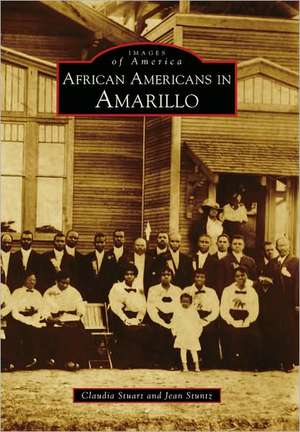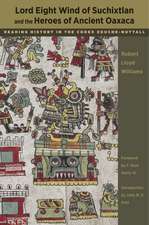African Americans in Amarillo: Images of America (Arcadia Publishing)
Autor Claudia Stuart, Jean Stuntzen Limba Engleză Paperback – 30 apr 2009
Din seria Images of America (Arcadia Publishing)
-
 Preț: 133.17 lei
Preț: 133.17 lei -
 Preț: 133.00 lei
Preț: 133.00 lei -
 Preț: 131.94 lei
Preț: 131.94 lei -
 Preț: 133.00 lei
Preț: 133.00 lei -
 Preț: 133.00 lei
Preț: 133.00 lei -
 Preț: 127.20 lei
Preț: 127.20 lei -
 Preț: 127.39 lei
Preț: 127.39 lei -
 Preț: 132.35 lei
Preț: 132.35 lei -
 Preț: 173.20 lei
Preț: 173.20 lei -
 Preț: 117.50 lei
Preț: 117.50 lei -
 Preț: 132.54 lei
Preț: 132.54 lei -
 Preț: 118.13 lei
Preț: 118.13 lei -
 Preț: 133.17 lei
Preț: 133.17 lei -
 Preț: 131.94 lei
Preț: 131.94 lei -
 Preț: 128.26 lei
Preț: 128.26 lei -
 Preț: 133.00 lei
Preț: 133.00 lei -
 Preț: 133.17 lei
Preț: 133.17 lei -
 Preț: 133.00 lei
Preț: 133.00 lei -
 Preț: 131.94 lei
Preț: 131.94 lei -
 Preț: 133.41 lei
Preț: 133.41 lei -
 Preț: 127.20 lei
Preț: 127.20 lei -
 Preț: 131.94 lei
Preț: 131.94 lei -
 Preț: 120.40 lei
Preț: 120.40 lei -
 Preț: 131.72 lei
Preț: 131.72 lei -
 Preț: 127.20 lei
Preț: 127.20 lei -
 Preț: 131.94 lei
Preț: 131.94 lei -
 Preț: 132.76 lei
Preț: 132.76 lei -
 Preț: 131.94 lei
Preț: 131.94 lei -
 Preț: 136.28 lei
Preț: 136.28 lei -
 Preț: 127.39 lei
Preț: 127.39 lei -
 Preț: 133.17 lei
Preț: 133.17 lei -
 Preț: 133.00 lei
Preț: 133.00 lei -
 Preț: 133.41 lei
Preț: 133.41 lei -
 Preț: 117.72 lei
Preț: 117.72 lei -
 Preț: 133.17 lei
Preț: 133.17 lei -
 Preț: 117.72 lei
Preț: 117.72 lei -
 Preț: 133.00 lei
Preț: 133.00 lei -
 Preț: 128.26 lei
Preț: 128.26 lei -
 Preț: 132.13 lei
Preț: 132.13 lei -
 Preț: 132.13 lei
Preț: 132.13 lei -
 Preț: 131.94 lei
Preț: 131.94 lei -
 Preț: 131.94 lei
Preț: 131.94 lei -
 Preț: 133.41 lei
Preț: 133.41 lei -
 Preț: 133.41 lei
Preț: 133.41 lei -
 Preț: 131.94 lei
Preț: 131.94 lei -
 Preț: 118.31 lei
Preț: 118.31 lei -
 Preț: 127.61 lei
Preț: 127.61 lei -
 Preț: 131.94 lei
Preț: 131.94 lei -
 Preț: 131.94 lei
Preț: 131.94 lei -
 Preț: 133.41 lei
Preț: 133.41 lei
Preț: 133.00 lei
Nou
Puncte Express: 200
Preț estimativ în valută:
25.45€ • 27.21$ • 21.22£
25.45€ • 27.21$ • 21.22£
Carte indisponibilă temporar
Doresc să fiu notificat când acest titlu va fi disponibil:
Se trimite...
Preluare comenzi: 021 569.72.76
Specificații
ISBN-13: 9780738571287
ISBN-10: 0738571288
Pagini: 128
Dimensiuni: 165 x 231 x 10 mm
Greutate: 0.32 kg
Editura: Arcadia Publishing (SC)
Seria Images of America (Arcadia Publishing)
ISBN-10: 0738571288
Pagini: 128
Dimensiuni: 165 x 231 x 10 mm
Greutate: 0.32 kg
Editura: Arcadia Publishing (SC)
Seria Images of America (Arcadia Publishing)
Descriere
Amarillo became a town in 1887 when merchants opened stores to cater to railroad workers. The first African Americans in the area were Jerry Callaway, who came to the area in 1888 with a white family, and Mathew "Bones" Hooks, a highly respected cowboy who moved to Amarillo in 1900 and later worked for the railroad. By 1908, five African American families had moved to Amarillo. The black community grew and people established churches, businesses, and schools. With the 1950s and 1960s, Amarillo citizens participated in ending segregation and bringing about equality. Today African Americans in Amarillo are still bound together by their churches but have access to many opportunities both locally and nationally. They are justifiably proud of their rich heritage.
Notă biografică
Churches, the Black Historical Cultural Center, fraternal organizations, and area families preserved their history in photographs. Claudia Stuart and Jean Stuntz, professors at nearby West Texas A&M University, gratefully acknowledge the contributions of both the pioneer families and the modern-day Amarillo citizens who have created and sustained this community.
















